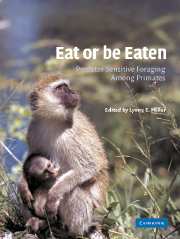Book contents
- Frontmatter
- Contents
- List of contributors
- Preface
- 1 An introduction to predator sensitive foraging
- PART I BIOLOGICAL VARIABLES
- PART II SOCIAL VARIABLES
- PART III ENVIRONMENTAL VARIABLES
- 12 Foraging female baboons exhibit similar patterns of antipredator vigilance across two populations
- 13 Foraging and safety in adult female blue monkeys in the Kakamega Forest, Kenya
- 14 Predicting predation risk for foraging, arboreal monkeys
- 15 Predator sensitive foraging in ateline primates
- 16 Antipredatory behavior in gibbons (Hylobates lar, Khao Yai/Thailand)
- Index
12 - Foraging female baboons exhibit similar patterns of antipredator vigilance across two populations
Published online by Cambridge University Press: 10 November 2009
- Frontmatter
- Contents
- List of contributors
- Preface
- 1 An introduction to predator sensitive foraging
- PART I BIOLOGICAL VARIABLES
- PART II SOCIAL VARIABLES
- PART III ENVIRONMENTAL VARIABLES
- 12 Foraging female baboons exhibit similar patterns of antipredator vigilance across two populations
- 13 Foraging and safety in adult female blue monkeys in the Kakamega Forest, Kenya
- 14 Predicting predation risk for foraging, arboreal monkeys
- 15 Predator sensitive foraging in ateline primates
- 16 Antipredatory behavior in gibbons (Hylobates lar, Khao Yai/Thailand)
- Index
Summary
Introduction
Predation pressure has long been considered a powerful selective force on primate behavior (Alexander 1974, Anderson 1986, Crook and Gartlan 1966, Dunbar 1988, Isbell 1994, van Schaik 1983, 1989). However, most studies that have investigated the importance of predation on primates have tended to focus on either patterns across different species (Anderson 1986, Cheney and Wrangham 1987, Goodman et al. 1993, Hill and Lee 1998, Isbell 1994) or patterns across individuals within a given population (e.g., Cowlishaw, 1997a, Isbell and Young 1993, Stanford 1995). In contrast, little attention has been paid to the consistency of antipredator strategies across different populations of the same primate species. Nevertheless, such patterns can potentially shed valuable light on intraspecific variation in tolerance to predation risk and the strategies used to reduce that risk, together with the differential costs and benefits of such strategies in different populations.
Baboons represent an ideal taxon for such an investigation, since predation risk in this species is relatively well understood (e.g., Cowlishaw 1994, 1997a) and the wealth of data available on their ecological and behavioral flexibility (Barton et al. 1996) permits detailed assessments on the impact of predation risk across a wide array of ecological conditions (e.g., Dunbar 1996). The evidence already available for baboons indicates that antipredator behavior is not fixed but that individuals invest differentially with response to the degree of predation risk. For example, baboons that live in small, high-risk, groups are more active in their use of refuges, such as tall trees and cliff faces, than are larger groups. Importantly, this pattern has been reported in more than one population: Amboseli, Kenya (Stacey 1986) and Tsaobis, Namibia (Cowlishaw 1997b).
- Type
- Chapter
- Information
- Eat or be EatenPredator Sensitive Foraging Among Primates, pp. 187 - 204Publisher: Cambridge University PressPrint publication year: 2002
- 14
- Cited by



